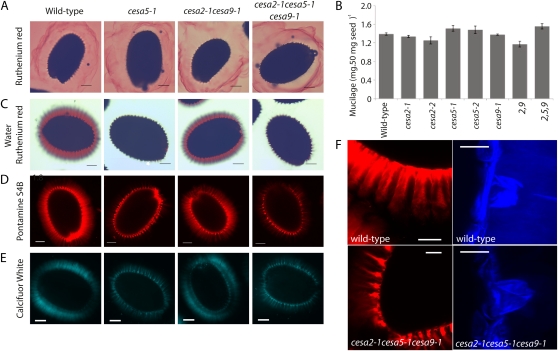Figure 7.
Mucilage attachment to the parent seed is mediated by CESA5 in Arabidopsis seeds. A, Ruthenium Red-stained seeds. B, Mucilage weights determined for wild-type and cesa mutant seeds. Error bars represent se of three replicates. C, Water-hydrated Ruthenium Red-stained seeds visualized by light microscopy in the wild type, cesa5-1, cesa2-1cesa9-1, and cesa2-1cesa5-1cesa9-1. Mutants cesa2-1, cesa2-2, cesa9-1, and cesa9-2 are not shown due to no observed mucilage phenotype. D and E, Pontamine S4B-stained (D) and Calcofluor White-stained (E) wild-type, cesa5-1, cesa2-1cesa9-1, and cesa2-1cesa5-1cesa9-1 mature seeds. Bars = 100 μm. F, High-magnification visualization of Pontamine S4B-labeled (whole seeds viewed by light microscopy) and Calcofluor White-labeled (three-dimensional reconstruction of a z-projection; side view via laser scanning confocal microscopy) seed coat cells in the wild type and cesa2-1cesa5-1cesa9-1. Bars = 10 μm. [See online article for color version of this figure.]

